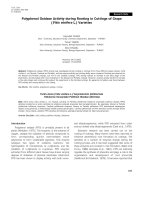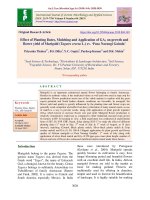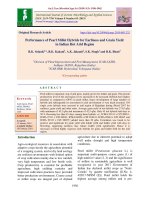Assessment of Tuberose (Polianthes tuberosa L.) varieties for growth and flower yield
Bạn đang xem bản rút gọn của tài liệu. Xem và tải ngay bản đầy đủ của tài liệu tại đây (158.9 KB, 5 trang )
Int.J.Curr.Microbiol.App.Sci (2020) 9(8): 1082-1086
International Journal of Current Microbiology and Applied Sciences
ISSN: 2319-7706 Volume 9 Number 8 (2020)
Journal homepage:
Original Research Article
/>
Assessment of Tuberose (Polianthes tuberosa L.) Varieties for
Growth and Flower Yield
V. Sivakumar1*, K. Kumanan2, A. Kamaraj3, R. Balakumbahan4 and V. Alex Albert5
1
Coconut Research Station, Aliyarnagar, Coimbatore - 642 101, India
Horticultural College and Research Institute for Women, Tiruchirapalli - 620 027, India
3
Agricultural College and Research Institute, Eachangkottai, Thanjavur -614 902, India
4
Horticultural College and Research Institute, Periyakulam, Theni- 625 604, India
5
ICAR-Krishi Vigyan Kendra, Sirugamani - 639 115, Tiruchirappalli District, India
2
*Corresponding author
ABSTRACT
Keywords
Tuberose
(Polianthes
tuberosa L.)
Varieties
Article Info
Accepted:
10 July 2020
Available Online:
10 August 2020
A field investigation on suitability assessment of tuberose varieties for growth and flower
yield characters was carried out at five different farmers’ fields at Valangaiman block of
Thiruvarur district during the year 2012-14. The trial was laid out in randomized block
design (RBD) with three varieties (Prajwal, Phule Rajini and local check) with five
replications. The observation on growth, flower yield and cost benefit ratio were recorded
and analysed statistically. The experimental results revealed that the highest plant height
(63.8cm), number leaves per plant (45.3), plant coverage (612.4 cm2), spike length (87.3),
rachis length (40.2cm), florets per spike (55.6), floret length (5.6cm), floret diameter
(4.2cm), weight of floret (1.5g), number spikes per plant (2.9), number of bulbs per plant
(17.2), bulb weight (12.3g), bulb diameter (1.9cm) and yield per hectare (15.2 t/ha)) were
recorded in Prajwal followed Phule Rajini. In the studied area Prajwal took 92 days for
first flowering against 123.6 days i local check. Regarding the economics of cultivation,
the variety Prajwal recorded higher gross income (Rs.3,04,000/ha), net income
(Rs.1,7,3000/ha) and benefit cost ration (3.5). Based on the performance it is concluded
that, prajwal variety is ideally suitable for commercial cultivation under Thiruvarur
condition.
Introduction
Tuberose (Polianthes tuberosa L.) is one of
the commercially significant loose and cut
flowers in India. Two group of tuberose
flowers viz., single and double cultivars are
available for cultivation. The waxy white
flowering spikes of both single as well as
double types of tuberose infuse the
environment with sweet perfume and because
of the longer table quality (Sadhu and Bose,
1973, Benschop et al., 1993). Tuberose is
cultivated on a large scale in Tamil Nadu,
Karnataka, West Bengal and Maharashtra.
Valuable natural aromatic oil is extracted
from the flowers fetches high cost in perfume
industry. It is widely grown as a specimen for
display as cut flower too. Its essential oil is
1082
Int.J.Curr.Microbiol.App.Sci (2020) 9(8): 1082-1086
exported at an attractive price to France, Italy
and other countries, as long as there is no
synthetic flavour to replace its fragrance.
There are only a few varieties and hybrids of
tuberose under cultivation. As the commercial
cultivation of tuberose is gaining importance,
identification and assessment of high yielding
varieties is necessary for particular region to
obtain sustainable and economic profit by the
farmers. Since the performances of crops may
vary from region to region (Kamble et al.,
2004) it is important to study the variation
and performance of varieties in a new location
to enhance the production efficiency. Hence,
the present field study was undertaken to find
out the suitable tuberose varieties for
Thiruvarur district of Tamil Nadu.
Materials and Methods
The present study was carried out at five
different farmers’ fields at Valangaiman block
of Thiruvarur district during the year 2012-14.
The location is situated at 10° 77” N latitude,
79° 37” E longitude and 17 m above mean sea
level. The investigational material includes
two improved varieties of tuberose varieties
viz., Prajwal, Phule Rajani along with local
check. The experiment was laid out in a
randomized block design (RBD) with five
replications.
The experiment plot was brought to a fine tilt
with four deep ploughings. Weeds, stubbles,
roots etc., were removed and farm yard
manure at the rate of 25 t ha-1 was applied at
the time of the last ploughing. After levelling,
raised beds of 1 m width and 1 m length were
formed and medium sized bulbs (3.0-3.5 cm
diameter) of about 25 grams were planted at a
spacing of 45 m x 20 m which accommodates
11 plants per square meter. Standard cultural
practices as recommended by the Tamil Nadu
Agricultural University were followed
throughout the experimentation. The data
were recorded in ten plants tagged from each
replication for growth, flower and yield
characters. The collected data were analysed
for statistical significance as per the methods
of Panse and Sukhatme, 1985.
Results and Discussion
All the growth parameters recorded showed
significant variation between the varieties
evaluated. The results revealed that, improved
varieties of tuberose performed better than
local check with respect to all plant growth
and yield characters. Among the improved
varieties, significant highest plant height
(63.8cm), number leaves per plant (45.3),
plant coverage (612.4 cm2), spike length
(87.3), rachis length (40.2cm), florets per
spike (55.6), floret length (5.6cm), floret
diameter (4.2cm), weight of floret (1.5 g) and
number of spikelet's per plant (2.9) were
reordered in Prajwal variety followed by
Phule Rajani. Similar results were also
reported by Gudi (2006) and Vijayalaxmi et
a., (2010). Varietal dissimilarity in
performance among the tuberose varieties
evaluated
was
also
observed
by
Ramachandrudu et al., (2009) and Prashanta
et al., (2016). Different varieties performed
better for different floral parameters which
might be due to the inherent capacity of the
particular genotype as well as the prevailing
climatic conditions during the growing period
(Urfi Fatmi and Devi Singh, 2020). Earliness
in flowering is an important character, which
helps farmers to fetch early market with
increased price. Accordingly, the variety
Prajwal took only 92.6 days to for the
commencement flowering against 101.5 days
and 123.6 days in Phule Rajani and local
check respectively.
Elite and vigorous propagating material is the
prerequisite for commercial production of any
crop. Bulb quantity, superiority and yield
provide added farm revenue in addition to the
sale of flower.
1083
Int.J.Curr.Microbiol.App.Sci (2020) 9(8): 1082-1086
Table.1 Growth and flower characters of tuberose varieties at Thiruvarur district
Variety
Plant
height
(cm)
Prajwal
63.8
Number
of
leaves/
plant
45.3
Plant
coverage
(cm2)
Days to
first
flowering
Spike
length
(cm)
Rachis
length
(cm)
Florets
/spike
Floret
length
(cm)
Floret
diameter
(cm)
4.2
Weight
of
floret
(g)
1.5
No. of
Spikes
per
plant
2.9
612.4
92.6
87.3
40.2
55.6
5.6
Phule Rajini
60.2
42.8
532.3
101.5
75.1
36.9
50.4
5.2
3.8
1.3
2.3
local check
52.3
31.6
326.6
123.6
62.8
32.8
38.8
4.3
3.2
0.9
1.9
SEd
1.1
0.7
8.9
2.1
1.4
0.6
1.1
0.1
0.1
0.03
0.04
CD(P=0.05%)
3.1
2.0
18.2
5.2
3.2
1.3
2.4
0.2
0.2
0.06
0.12
Table.2 Bulb characters and yield of tuberose varieties at Thiruvarur district
Variety
Prajwal
Phule Rajini
local check
SEd
CD(P=0.05%)
No. of bulbs Bulb weight Bulb diameter
/ plant
(g)
(cm)
17.2
12.3
1.9
14.3
9.5
1.6
12.8
7.6
1.2
0.3
0.2
0.03
0.7
0.5
0.07
Yield per hectare
(q/ha)
15.2
13.6
10.6
0.3
0.6
Table.3 Economics of tuberose varieties at Thiruvarur district
Variety
Prajwal
Phule Rajini
local check
Yield per ha
(t/ha)
15.2
13.6
10.6
Gross Cost
(Rs.)
85000/ha
85000/ha
75000/ha
Gross
Income (Rs.)
304000/ha
272000/ha
190800/ha
1084
Net Returns
(Rs.)
173000/ha
146000/ha
111000/ha
B:C ratio
3.5
3.2
2.5
Int.J.Curr.Microbiol.App.Sci (2020) 9(8): 1082-1086
The bulb size plays an essential role on the
growth and flowering of tuberose and it
manipulate the sprouting of bulb (Sadhu and
Das, 1978; Pathak et al., 1980). Bulb volume
is also having positive correlation with early
flowering and higher yield of flower spikes
(Yadav et al., 1985). In the present study
significant differences in bulb characters
among the varieties were noticed. The
maximum number of bulb per plant (17.2),
bulb weight (12.3g), bulb diameter (1.9cm)
and flower yield (15.2 t/ha) were registered
by the variety Prajwal flowed by Phule Rajini.
The lowest number of bulb per plant (12.8),
bulb weight (7.6g), bulb diameter (1.2cm) and
flower yield (10.6 t/ha) were recorded by the
local check. The favourable bulb parameters
by Prajwal will be utilized for production
elite, healthy and vigorous planting material
for next season. Higher reserve food in bigger
bulbs and translocation of reserved energy
during plant growth phase ultimately helps in
better establishment and growth. With regard
to spike length and flower yield, the variety
Prajwal showed better performance than other
tested types. This might be due to the wide
adoptable capacity of the particular variety to
diverse climatic conditions (Bindiya et al.,
2018)
Economics
Better adoptability, yielding capability and
marketability in tuberose plant are the direct
signs to fetch better returns. Though the gross
cost of cultivation of local type was recorded
the lowest due its reduced cost of planting
materials the improved varieties showed
better performance in case of yield characters
thereby the net returns were higher than in
local types. Among the tuberose varieties,
market preference was high for var. Prajwal
and fetched elevated prices. Prajwal recorded
the highest net profit of Rs.1,73,000/ha with
the benefit to cost ratio of 3.5 followed by
Phule Rajini (Rs. 1,46,000/-ha, 3.2) while the
local check registered the least net profit of
Rs. 1,11,000/-ha and B:C ratio of 2.5.
Through this assessment it was found that
farmers were very much convinced with the
performance of tuberose variety Prajwal,
which obtain higher income, higher yield
when compared with Phule Rajini and local
check..
References
Bindiya C Naik, Kamble, B. S., Shantappa
Tirakannanavar and Savita Parit. 2018.
Evaluation of Different Genotypes of
Tuberose (Polianthes tuberosa L.) for
Growth,
Flowering
and
Yield
Characters.
Int.J.Curr.Microbiol.App.Sci.7(07):
4135-4141.
Benschop, M., De Hertogh, A., Le Nard M
(1993). The physiology of flower bulbs
(Edn) Elsevier, Amsterdam, The
Netherlands 589-601
Gudi, G. (2006) Evaluation of tuberose
varieties. Thesis submitted to University
of Agricultural Sciences, Dharwad, and
Karnataka.
Kamble, BS., Reddy BS., Patil RT., Kulkarni
BS. 2004. Performance of gladiolus
(Gladiolus hybridus Hort.) cultivars for
flowering and flower quality. J
Ornamental Hort.7: 51-60.
Panse V G and Sukhatme. P V (1985).
Statistical Methods for Agricultural
Workers. Second Edition. Indian
Council of Agricultural Research, New
Delhi: 356.
Pathak, S., Choudhuri, MA and Chatterjee,
SK (1980). Indian Journal of Plant
Physiology, 23: 4754.
Prashanta, M., Punetha, P., Rana, DK.
2016.Evaluation of tuberose genotypes
for vegetative, floral and bulb yielding
attributes under the valley conditions of
garhwal Himalayas. Int J Agri. Sci.
8(62):3522- 3524.
1085
Int.J.Curr.Microbiol.App.Sci (2020) 9(8): 1082-1086
Ramachandrudu, K., Thangam, M. 2009.
Performance of tuberose (Polianthes
tuberosa L.) cultivars in Goa. J Horti.
Sci. 4(1):76-77.
Sadhu, MK, Bose, TK. 1973. Tuberose for
most artistic garlands. Indian Hort. 18:
17-20.
Urfi Fatmi and Devi Singh. 2020. Lower
quality, yield and bulb production of
different varieties of tuberose as
affected by different planting time and
geometry under Prayagraj agro-climatic
conditions. Journal of Pharmacognosy
and Phytochemistry.9(2): 74-77.
Vijayalaxmi, M., Manohar Rao A.,
Padmavatamma AS. and Siva Shanker,
A. 2010. Evaluation and variability
studies in tuberose (Polianthes tuberosa
L.) single cultivars. J Ornamental
Hort.13: 251- 256.
Yadav, L P., Bose, TK., and Maity, RG. 1985.
Response of tuberose (Polianthes
tuberosa L.) to nitrogen and phosphorus
fertilization. Prog Hort. 17(2):83-86.
How to cite this article:
Sivakumar, V., K. Kumanan, A. Kamaraj, R. Balakumbahan and Alex Albert, V. 2020.
Assessment of Tuberose (Polianthes tuberosa L.) Varieties for Growth and Flower Yield.
Int.J.Curr.Microbiol.App.Sci. 9(08): 1082-1086. doi: />
1086









